Gender and Public Space: Examining Gendered Urban Environments
VerifiedAdded on 2023/06/05
|26
|7671
|438
Essay
AI Summary
This essay examines the multifaceted relationship between gender and public space, exploring key concepts such as equality, social protection, and the right to the city. It delves into gender mainstreaming in urban planning, emphasizing the importance of creating gender-sensitive and women-friendly cities. The essay discusses the challenges women face in urban environments, including issues related to transport, neighborhood design, and access to parks. It analyzes the impact of patriarchal structures and highlights the need for feminist urbanism to ensure women's equal participation in shaping urban spaces. The essay also touches upon the gaps in the existing literature and provides recommendations for implementing gender-sensitive design principles to foster inclusive and safe public spaces for all.

Running head: GENDER AND PUBLIC SPACE
Gender and public space
Name of the student:
Name of the university:
Author note:
Gender and public space
Name of the student:
Name of the university:
Author note:
Paraphrase This Document
Need a fresh take? Get an instant paraphrase of this document with our AI Paraphraser

1GENDER AND PUBLIC SPACE
Table of Contents
1. Introduction..................................................................................................................................2
1.1 Key Concepts.........................................................................................................................3
2. Gender mainstreaming in urban planning....................................................................................4
3. Right to city.................................................................................................................................5
4. Gender and city............................................................................................................................6
4. 1 Creating gender sensitive and women friendly cities...........................................................8
4.2 Gender differences and transport.........................................................................................10
5. Gender and the neighborhood....................................................................................................11
5.1 Gender and parks.................................................................................................................13
7. Conclusion.................................................................................................................................15
7.1 Recommendations of Implementing a Gender-Sensitive Design........................................16
7. 2 Gaps in literature review.....................................................................................................16
References:....................................................................................................................................18
Table of Contents
1. Introduction..................................................................................................................................2
1.1 Key Concepts.........................................................................................................................3
2. Gender mainstreaming in urban planning....................................................................................4
3. Right to city.................................................................................................................................5
4. Gender and city............................................................................................................................6
4. 1 Creating gender sensitive and women friendly cities...........................................................8
4.2 Gender differences and transport.........................................................................................10
5. Gender and the neighborhood....................................................................................................11
5.1 Gender and parks.................................................................................................................13
7. Conclusion.................................................................................................................................15
7.1 Recommendations of Implementing a Gender-Sensitive Design........................................16
7. 2 Gaps in literature review.....................................................................................................16
References:....................................................................................................................................18

2GENDER AND PUBLIC SPACE
1. Introduction
According to Low and Smith (2013), public space may be defined in simple terms as a
space or place which is open and thus accessible to all people, irrespective of their class, gender,
ethnicity and other such attributes. For instance, public parks, roads or public buildings may be
called examples of public space. The United Nations classified public space as an open area
where all individuals would feel safe from discrimination or any kind of harassment. As a matter
of fact, it can be stated that public places are pivotal in facilitating favorable economic and social
life in the local communities. Public space, and efficient maintenance of it, would lead to
sustainable communities(Baxter 2016).In other words, public spaces may be termed as mutual
resources within a community where individuals can get together to share experiences and create
value.
Campanella (2017) argues that it was urban planning theorist, Jane Jacobs who
revolutionized the concept of urban planning and public space. Jacobs had opined that the
concept of public space must be incorporated into urban policies, owing to the loss of urban
neighborhoods, thus adversely affecting local citizens. Jacobs had based her statements on her
observation of growing crime rates in American cities in the twentieth century. She had pleaded
for safety and safety measures in public space. She had opposed to the idea of an orthodox
urbanism, which she believed was the source of crime(Jacobs 2016). Yet, in the twenty first
century, cities have become all the more vulnerable to threats and violence. Gender inequality,
conflict, drug trafficking are just some of the issues plaguing urban contexts. Thus, it can safely
be asserted that urban planning and public space would have to be critically reviewed. In the
1. Introduction
According to Low and Smith (2013), public space may be defined in simple terms as a
space or place which is open and thus accessible to all people, irrespective of their class, gender,
ethnicity and other such attributes. For instance, public parks, roads or public buildings may be
called examples of public space. The United Nations classified public space as an open area
where all individuals would feel safe from discrimination or any kind of harassment. As a matter
of fact, it can be stated that public places are pivotal in facilitating favorable economic and social
life in the local communities. Public space, and efficient maintenance of it, would lead to
sustainable communities(Baxter 2016).In other words, public spaces may be termed as mutual
resources within a community where individuals can get together to share experiences and create
value.
Campanella (2017) argues that it was urban planning theorist, Jane Jacobs who
revolutionized the concept of urban planning and public space. Jacobs had opined that the
concept of public space must be incorporated into urban policies, owing to the loss of urban
neighborhoods, thus adversely affecting local citizens. Jacobs had based her statements on her
observation of growing crime rates in American cities in the twentieth century. She had pleaded
for safety and safety measures in public space. She had opposed to the idea of an orthodox
urbanism, which she believed was the source of crime(Jacobs 2016). Yet, in the twenty first
century, cities have become all the more vulnerable to threats and violence. Gender inequality,
conflict, drug trafficking are just some of the issues plaguing urban contexts. Thus, it can safely
be asserted that urban planning and public space would have to be critically reviewed. In the
⊘ This is a preview!⊘
Do you want full access?
Subscribe today to unlock all pages.

Trusted by 1+ million students worldwide
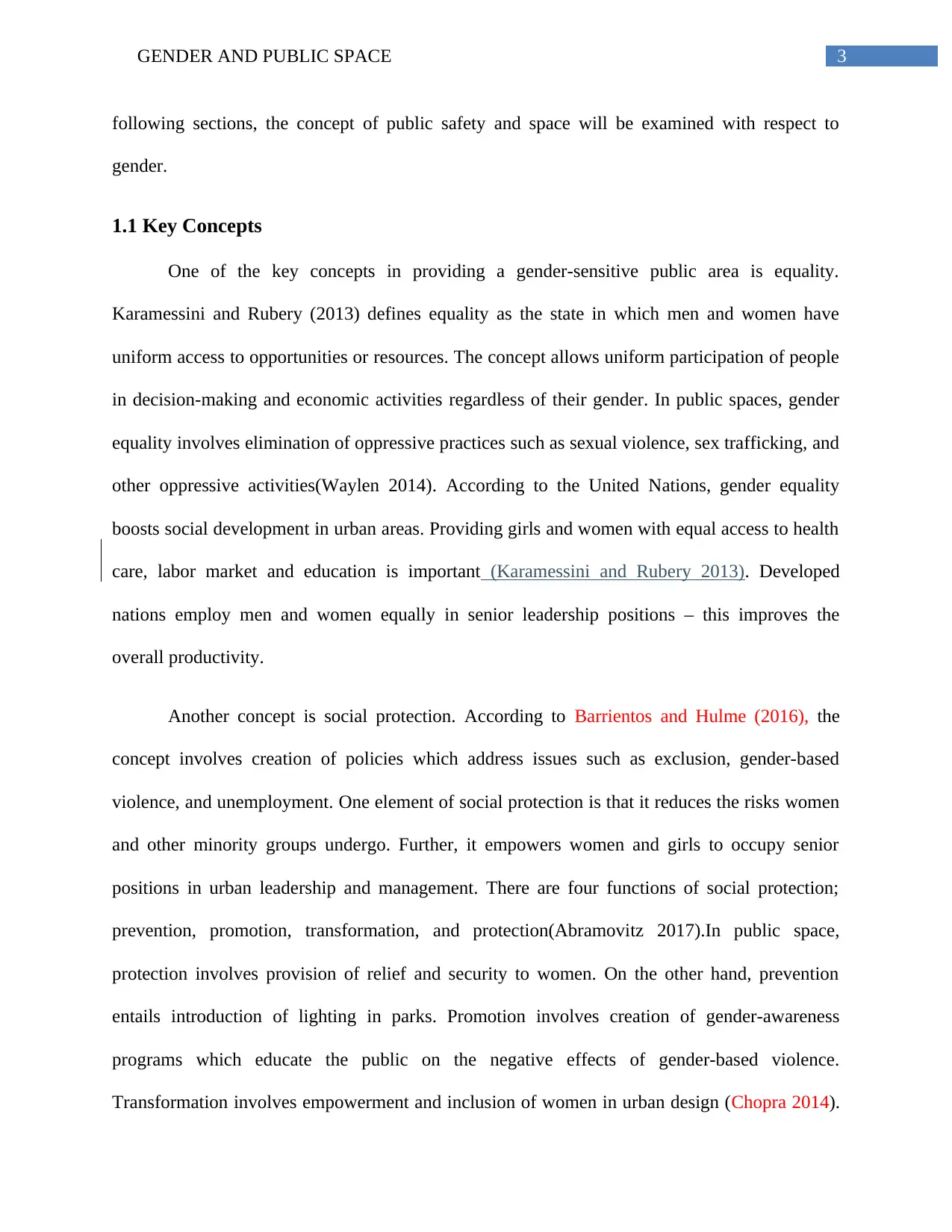
3GENDER AND PUBLIC SPACE
following sections, the concept of public safety and space will be examined with respect to
gender.
1.1 Key Concepts
One of the key concepts in providing a gender-sensitive public area is equality.
Karamessini and Rubery (2013) defines equality as the state in which men and women have
uniform access to opportunities or resources. The concept allows uniform participation of people
in decision-making and economic activities regardless of their gender. In public spaces, gender
equality involves elimination of oppressive practices such as sexual violence, sex trafficking, and
other oppressive activities(Waylen 2014). According to the United Nations, gender equality
boosts social development in urban areas. Providing girls and women with equal access to health
care, labor market and education is important (Karamessini and Rubery 2013). Developed
nations employ men and women equally in senior leadership positions – this improves the
overall productivity.
Another concept is social protection. According to Barrientos and Hulme (2016), the
concept involves creation of policies which address issues such as exclusion, gender-based
violence, and unemployment. One element of social protection is that it reduces the risks women
and other minority groups undergo. Further, it empowers women and girls to occupy senior
positions in urban leadership and management. There are four functions of social protection;
prevention, promotion, transformation, and protection(Abramovitz 2017).In public space,
protection involves provision of relief and security to women. On the other hand, prevention
entails introduction of lighting in parks. Promotion involves creation of gender-awareness
programs which educate the public on the negative effects of gender-based violence.
Transformation involves empowerment and inclusion of women in urban design (Chopra 2014).
following sections, the concept of public safety and space will be examined with respect to
gender.
1.1 Key Concepts
One of the key concepts in providing a gender-sensitive public area is equality.
Karamessini and Rubery (2013) defines equality as the state in which men and women have
uniform access to opportunities or resources. The concept allows uniform participation of people
in decision-making and economic activities regardless of their gender. In public spaces, gender
equality involves elimination of oppressive practices such as sexual violence, sex trafficking, and
other oppressive activities(Waylen 2014). According to the United Nations, gender equality
boosts social development in urban areas. Providing girls and women with equal access to health
care, labor market and education is important (Karamessini and Rubery 2013). Developed
nations employ men and women equally in senior leadership positions – this improves the
overall productivity.
Another concept is social protection. According to Barrientos and Hulme (2016), the
concept involves creation of policies which address issues such as exclusion, gender-based
violence, and unemployment. One element of social protection is that it reduces the risks women
and other minority groups undergo. Further, it empowers women and girls to occupy senior
positions in urban leadership and management. There are four functions of social protection;
prevention, promotion, transformation, and protection(Abramovitz 2017).In public space,
protection involves provision of relief and security to women. On the other hand, prevention
entails introduction of lighting in parks. Promotion involves creation of gender-awareness
programs which educate the public on the negative effects of gender-based violence.
Transformation involves empowerment and inclusion of women in urban design (Chopra 2014).
Paraphrase This Document
Need a fresh take? Get an instant paraphrase of this document with our AI Paraphraser
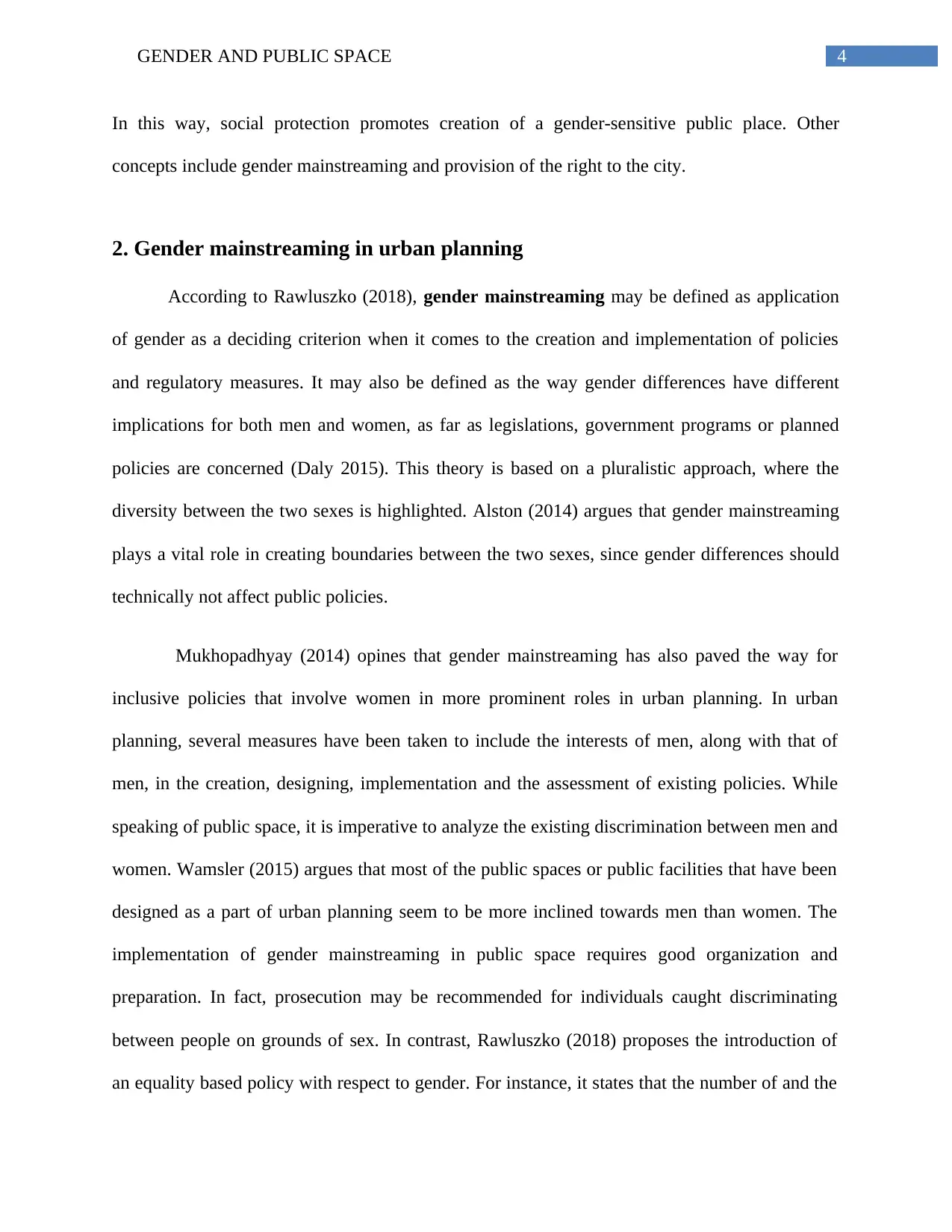
4GENDER AND PUBLIC SPACE
In this way, social protection promotes creation of a gender-sensitive public place. Other
concepts include gender mainstreaming and provision of the right to the city.
2. Gender mainstreaming in urban planning
According to Rawluszko (2018), gender mainstreaming may be defined as application
of gender as a deciding criterion when it comes to the creation and implementation of policies
and regulatory measures. It may also be defined as the way gender differences have different
implications for both men and women, as far as legislations, government programs or planned
policies are concerned (Daly 2015). This theory is based on a pluralistic approach, where the
diversity between the two sexes is highlighted. Alston (2014) argues that gender mainstreaming
plays a vital role in creating boundaries between the two sexes, since gender differences should
technically not affect public policies.
Mukhopadhyay (2014) opines that gender mainstreaming has also paved the way for
inclusive policies that involve women in more prominent roles in urban planning. In urban
planning, several measures have been taken to include the interests of men, along with that of
men, in the creation, designing, implementation and the assessment of existing policies. While
speaking of public space, it is imperative to analyze the existing discrimination between men and
women. Wamsler (2015) argues that most of the public spaces or public facilities that have been
designed as a part of urban planning seem to be more inclined towards men than women. The
implementation of gender mainstreaming in public space requires good organization and
preparation. In fact, prosecution may be recommended for individuals caught discriminating
between people on grounds of sex. In contrast, Rawluszko (2018) proposes the introduction of
an equality based policy with respect to gender. For instance, it states that the number of and the
In this way, social protection promotes creation of a gender-sensitive public place. Other
concepts include gender mainstreaming and provision of the right to the city.
2. Gender mainstreaming in urban planning
According to Rawluszko (2018), gender mainstreaming may be defined as application
of gender as a deciding criterion when it comes to the creation and implementation of policies
and regulatory measures. It may also be defined as the way gender differences have different
implications for both men and women, as far as legislations, government programs or planned
policies are concerned (Daly 2015). This theory is based on a pluralistic approach, where the
diversity between the two sexes is highlighted. Alston (2014) argues that gender mainstreaming
plays a vital role in creating boundaries between the two sexes, since gender differences should
technically not affect public policies.
Mukhopadhyay (2014) opines that gender mainstreaming has also paved the way for
inclusive policies that involve women in more prominent roles in urban planning. In urban
planning, several measures have been taken to include the interests of men, along with that of
men, in the creation, designing, implementation and the assessment of existing policies. While
speaking of public space, it is imperative to analyze the existing discrimination between men and
women. Wamsler (2015) argues that most of the public spaces or public facilities that have been
designed as a part of urban planning seem to be more inclined towards men than women. The
implementation of gender mainstreaming in public space requires good organization and
preparation. In fact, prosecution may be recommended for individuals caught discriminating
between people on grounds of sex. In contrast, Rawluszko (2018) proposes the introduction of
an equality based policy with respect to gender. For instance, it states that the number of and the
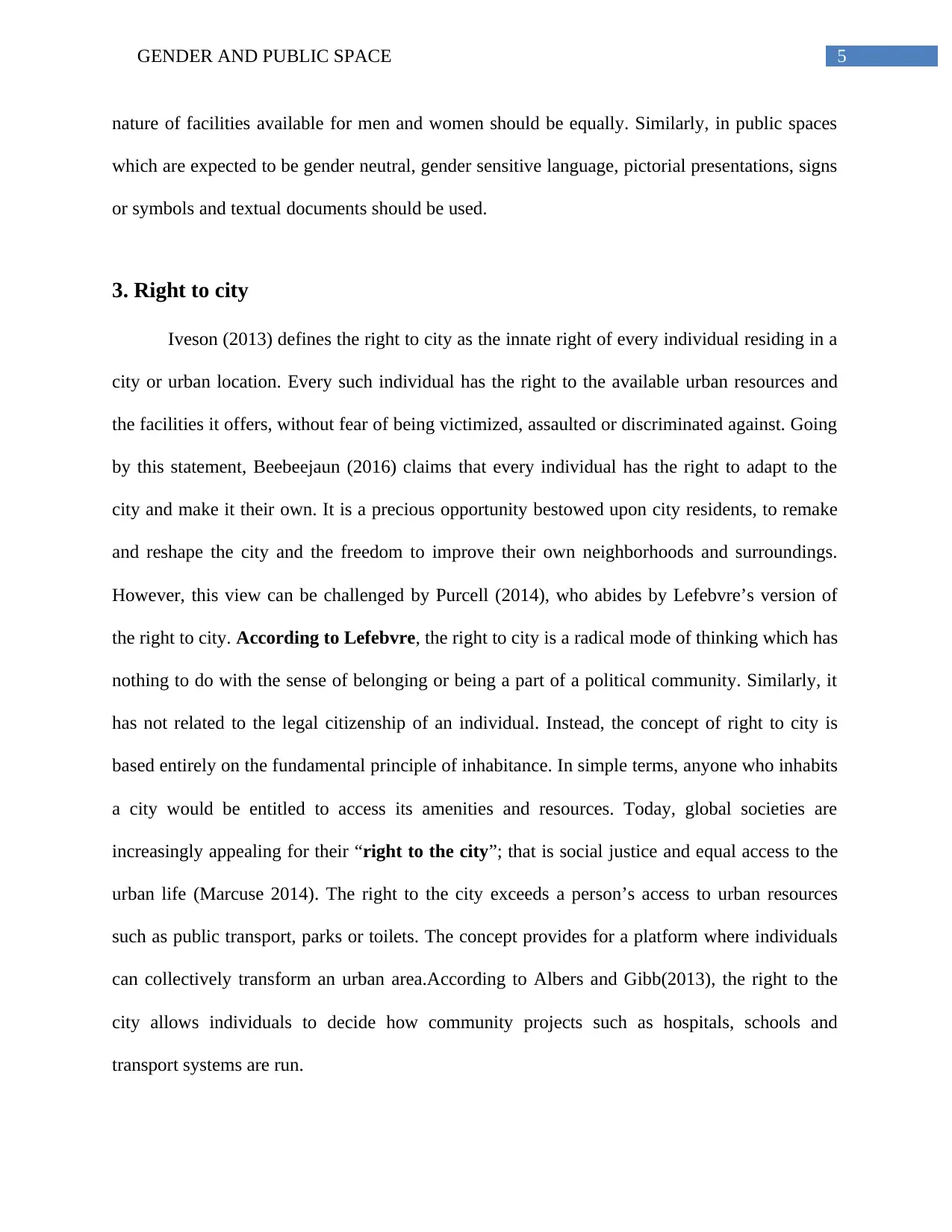
5GENDER AND PUBLIC SPACE
nature of facilities available for men and women should be equally. Similarly, in public spaces
which are expected to be gender neutral, gender sensitive language, pictorial presentations, signs
or symbols and textual documents should be used.
3. Right to city
Iveson (2013) defines the right to city as the innate right of every individual residing in a
city or urban location. Every such individual has the right to the available urban resources and
the facilities it offers, without fear of being victimized, assaulted or discriminated against. Going
by this statement, Beebeejaun (2016) claims that every individual has the right to adapt to the
city and make it their own. It is a precious opportunity bestowed upon city residents, to remake
and reshape the city and the freedom to improve their own neighborhoods and surroundings.
However, this view can be challenged by Purcell (2014), who abides by Lefebvre’s version of
the right to city. According to Lefebvre, the right to city is a radical mode of thinking which has
nothing to do with the sense of belonging or being a part of a political community. Similarly, it
has not related to the legal citizenship of an individual. Instead, the concept of right to city is
based entirely on the fundamental principle of inhabitance. In simple terms, anyone who inhabits
a city would be entitled to access its amenities and resources. Today, global societies are
increasingly appealing for their “right to the city”; that is social justice and equal access to the
urban life (Marcuse 2014). The right to the city exceeds a person’s access to urban resources
such as public transport, parks or toilets. The concept provides for a platform where individuals
can collectively transform an urban area.According to Albers and Gibb(2013), the right to the
city allows individuals to decide how community projects such as hospitals, schools and
transport systems are run.
nature of facilities available for men and women should be equally. Similarly, in public spaces
which are expected to be gender neutral, gender sensitive language, pictorial presentations, signs
or symbols and textual documents should be used.
3. Right to city
Iveson (2013) defines the right to city as the innate right of every individual residing in a
city or urban location. Every such individual has the right to the available urban resources and
the facilities it offers, without fear of being victimized, assaulted or discriminated against. Going
by this statement, Beebeejaun (2016) claims that every individual has the right to adapt to the
city and make it their own. It is a precious opportunity bestowed upon city residents, to remake
and reshape the city and the freedom to improve their own neighborhoods and surroundings.
However, this view can be challenged by Purcell (2014), who abides by Lefebvre’s version of
the right to city. According to Lefebvre, the right to city is a radical mode of thinking which has
nothing to do with the sense of belonging or being a part of a political community. Similarly, it
has not related to the legal citizenship of an individual. Instead, the concept of right to city is
based entirely on the fundamental principle of inhabitance. In simple terms, anyone who inhabits
a city would be entitled to access its amenities and resources. Today, global societies are
increasingly appealing for their “right to the city”; that is social justice and equal access to the
urban life (Marcuse 2014). The right to the city exceeds a person’s access to urban resources
such as public transport, parks or toilets. The concept provides for a platform where individuals
can collectively transform an urban area.According to Albers and Gibb(2013), the right to the
city allows individuals to decide how community projects such as hospitals, schools and
transport systems are run.
⊘ This is a preview!⊘
Do you want full access?
Subscribe today to unlock all pages.

Trusted by 1+ million students worldwide
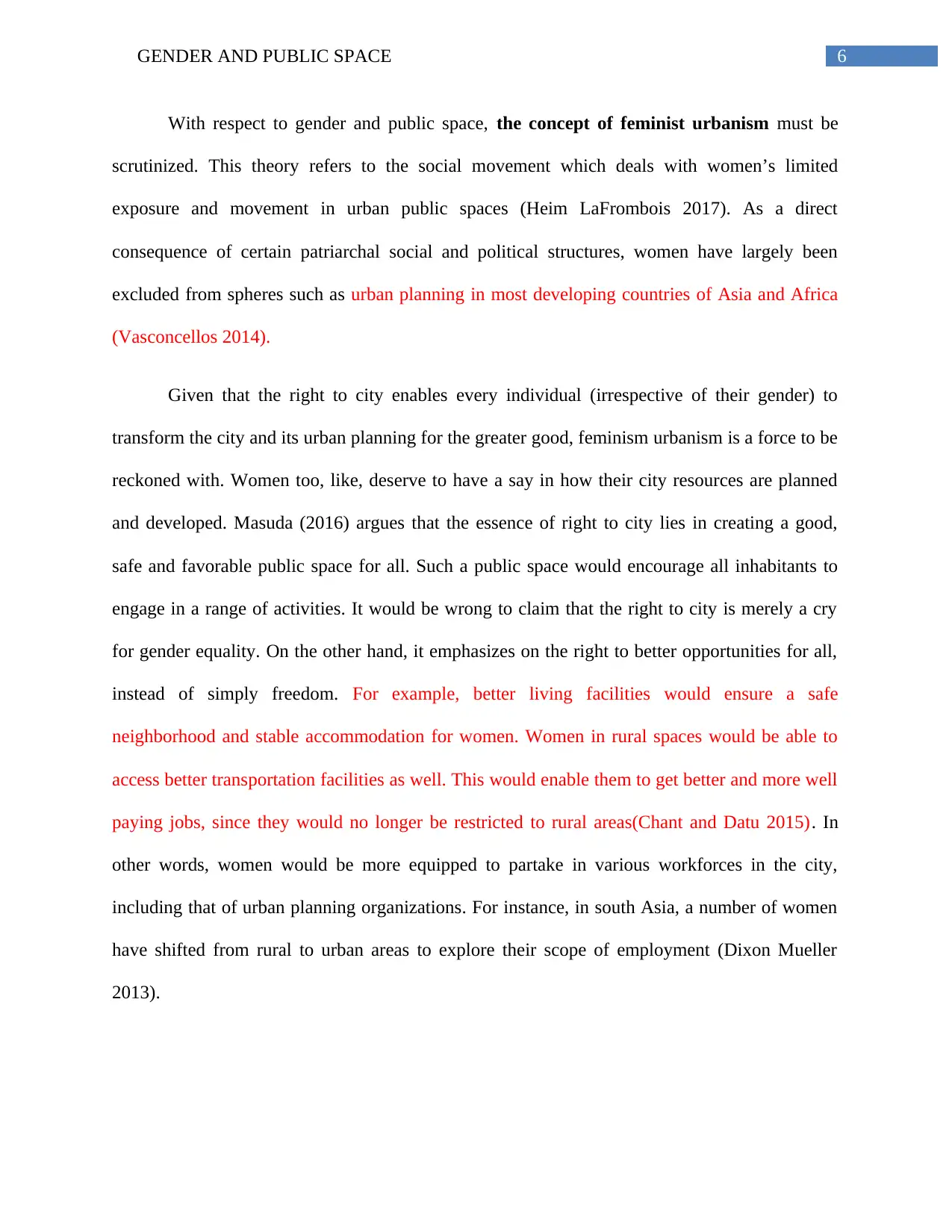
6GENDER AND PUBLIC SPACE
With respect to gender and public space, the concept of feminist urbanism must be
scrutinized. This theory refers to the social movement which deals with women’s limited
exposure and movement in urban public spaces (Heim LaFrombois 2017). As a direct
consequence of certain patriarchal social and political structures, women have largely been
excluded from spheres such as urban planning in most developing countries of Asia and Africa
(Vasconcellos 2014).
Given that the right to city enables every individual (irrespective of their gender) to
transform the city and its urban planning for the greater good, feminism urbanism is a force to be
reckoned with. Women too, like, deserve to have a say in how their city resources are planned
and developed. Masuda (2016) argues that the essence of right to city lies in creating a good,
safe and favorable public space for all. Such a public space would encourage all inhabitants to
engage in a range of activities. It would be wrong to claim that the right to city is merely a cry
for gender equality. On the other hand, it emphasizes on the right to better opportunities for all,
instead of simply freedom. For example, better living facilities would ensure a safe
neighborhood and stable accommodation for women. Women in rural spaces would be able to
access better transportation facilities as well. This would enable them to get better and more well
paying jobs, since they would no longer be restricted to rural areas(Chant and Datu 2015). In
other words, women would be more equipped to partake in various workforces in the city,
including that of urban planning organizations. For instance, in south Asia, a number of women
have shifted from rural to urban areas to explore their scope of employment (Dixon Mueller
2013).
With respect to gender and public space, the concept of feminist urbanism must be
scrutinized. This theory refers to the social movement which deals with women’s limited
exposure and movement in urban public spaces (Heim LaFrombois 2017). As a direct
consequence of certain patriarchal social and political structures, women have largely been
excluded from spheres such as urban planning in most developing countries of Asia and Africa
(Vasconcellos 2014).
Given that the right to city enables every individual (irrespective of their gender) to
transform the city and its urban planning for the greater good, feminism urbanism is a force to be
reckoned with. Women too, like, deserve to have a say in how their city resources are planned
and developed. Masuda (2016) argues that the essence of right to city lies in creating a good,
safe and favorable public space for all. Such a public space would encourage all inhabitants to
engage in a range of activities. It would be wrong to claim that the right to city is merely a cry
for gender equality. On the other hand, it emphasizes on the right to better opportunities for all,
instead of simply freedom. For example, better living facilities would ensure a safe
neighborhood and stable accommodation for women. Women in rural spaces would be able to
access better transportation facilities as well. This would enable them to get better and more well
paying jobs, since they would no longer be restricted to rural areas(Chant and Datu 2015). In
other words, women would be more equipped to partake in various workforces in the city,
including that of urban planning organizations. For instance, in south Asia, a number of women
have shifted from rural to urban areas to explore their scope of employment (Dixon Mueller
2013).
Paraphrase This Document
Need a fresh take? Get an instant paraphrase of this document with our AI Paraphraser
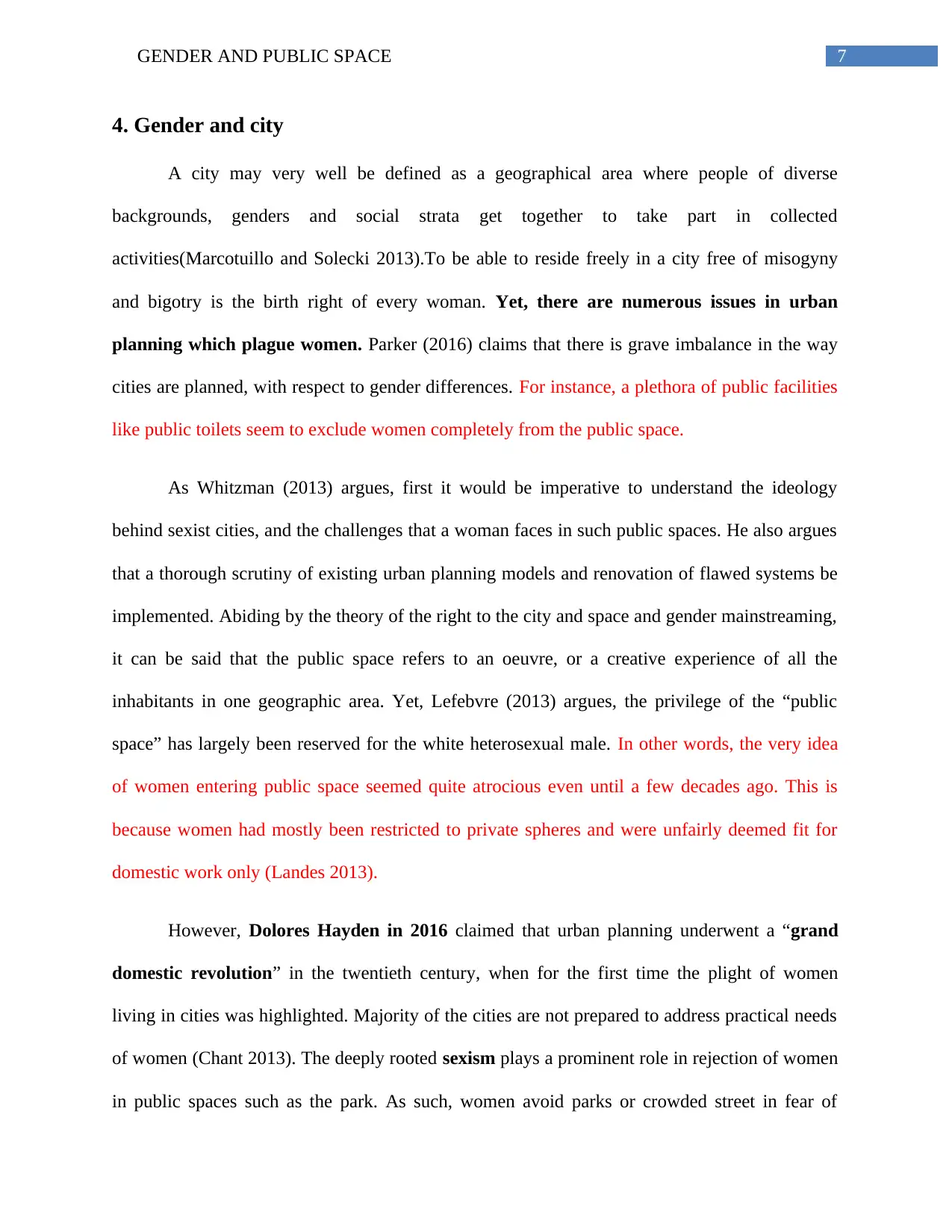
7GENDER AND PUBLIC SPACE
4. Gender and city
A city may very well be defined as a geographical area where people of diverse
backgrounds, genders and social strata get together to take part in collected
activities(Marcotuillo and Solecki 2013).To be able to reside freely in a city free of misogyny
and bigotry is the birth right of every woman. Yet, there are numerous issues in urban
planning which plague women. Parker (2016) claims that there is grave imbalance in the way
cities are planned, with respect to gender differences. For instance, a plethora of public facilities
like public toilets seem to exclude women completely from the public space.
As Whitzman (2013) argues, first it would be imperative to understand the ideology
behind sexist cities, and the challenges that a woman faces in such public spaces. He also argues
that a thorough scrutiny of existing urban planning models and renovation of flawed systems be
implemented. Abiding by the theory of the right to the city and space and gender mainstreaming,
it can be said that the public space refers to an oeuvre, or a creative experience of all the
inhabitants in one geographic area. Yet, Lefebvre (2013) argues, the privilege of the “public
space” has largely been reserved for the white heterosexual male. In other words, the very idea
of women entering public space seemed quite atrocious even until a few decades ago. This is
because women had mostly been restricted to private spheres and were unfairly deemed fit for
domestic work only (Landes 2013).
However, Dolores Hayden in 2016 claimed that urban planning underwent a “grand
domestic revolution” in the twentieth century, when for the first time the plight of women
living in cities was highlighted. Majority of the cities are not prepared to address practical needs
of women (Chant 2013). The deeply rooted sexism plays a prominent role in rejection of women
in public spaces such as the park. As such, women avoid parks or crowded street in fear of
4. Gender and city
A city may very well be defined as a geographical area where people of diverse
backgrounds, genders and social strata get together to take part in collected
activities(Marcotuillo and Solecki 2013).To be able to reside freely in a city free of misogyny
and bigotry is the birth right of every woman. Yet, there are numerous issues in urban
planning which plague women. Parker (2016) claims that there is grave imbalance in the way
cities are planned, with respect to gender differences. For instance, a plethora of public facilities
like public toilets seem to exclude women completely from the public space.
As Whitzman (2013) argues, first it would be imperative to understand the ideology
behind sexist cities, and the challenges that a woman faces in such public spaces. He also argues
that a thorough scrutiny of existing urban planning models and renovation of flawed systems be
implemented. Abiding by the theory of the right to the city and space and gender mainstreaming,
it can be said that the public space refers to an oeuvre, or a creative experience of all the
inhabitants in one geographic area. Yet, Lefebvre (2013) argues, the privilege of the “public
space” has largely been reserved for the white heterosexual male. In other words, the very idea
of women entering public space seemed quite atrocious even until a few decades ago. This is
because women had mostly been restricted to private spheres and were unfairly deemed fit for
domestic work only (Landes 2013).
However, Dolores Hayden in 2016 claimed that urban planning underwent a “grand
domestic revolution” in the twentieth century, when for the first time the plight of women
living in cities was highlighted. Majority of the cities are not prepared to address practical needs
of women (Chant 2013). The deeply rooted sexism plays a prominent role in rejection of women
in public spaces such as the park. As such, women avoid parks or crowded street in fear of
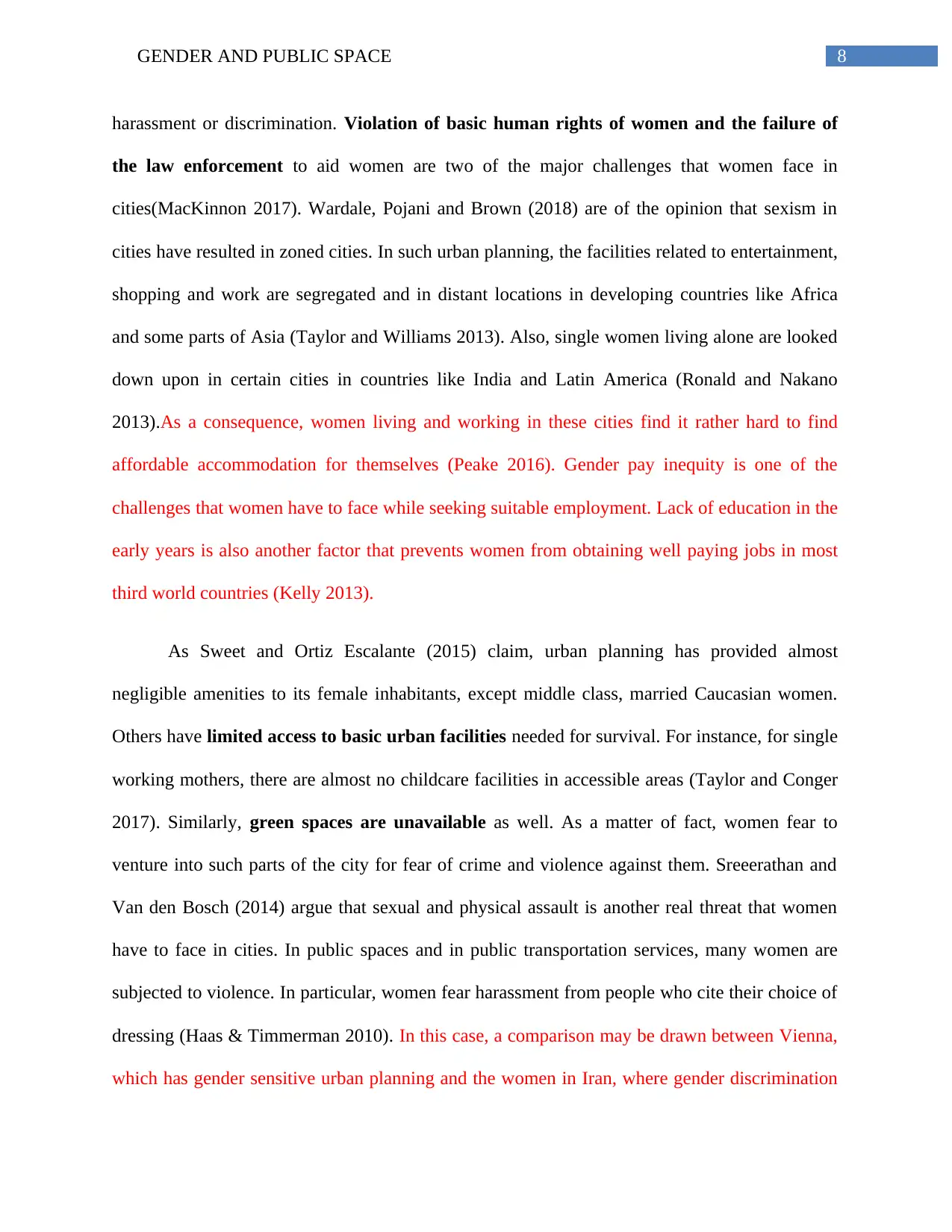
8GENDER AND PUBLIC SPACE
harassment or discrimination. Violation of basic human rights of women and the failure of
the law enforcement to aid women are two of the major challenges that women face in
cities(MacKinnon 2017). Wardale, Pojani and Brown (2018) are of the opinion that sexism in
cities have resulted in zoned cities. In such urban planning, the facilities related to entertainment,
shopping and work are segregated and in distant locations in developing countries like Africa
and some parts of Asia (Taylor and Williams 2013). Also, single women living alone are looked
down upon in certain cities in countries like India and Latin America (Ronald and Nakano
2013).As a consequence, women living and working in these cities find it rather hard to find
affordable accommodation for themselves (Peake 2016). Gender pay inequity is one of the
challenges that women have to face while seeking suitable employment. Lack of education in the
early years is also another factor that prevents women from obtaining well paying jobs in most
third world countries (Kelly 2013).
As Sweet and Ortiz Escalante (2015) claim, urban planning has provided almost
negligible amenities to its female inhabitants, except middle class, married Caucasian women.
Others have limited access to basic urban facilities needed for survival. For instance, for single
working mothers, there are almost no childcare facilities in accessible areas (Taylor and Conger
2017). Similarly, green spaces are unavailable as well. As a matter of fact, women fear to
venture into such parts of the city for fear of crime and violence against them. Sreeerathan and
Van den Bosch (2014) argue that sexual and physical assault is another real threat that women
have to face in cities. In public spaces and in public transportation services, many women are
subjected to violence. In particular, women fear harassment from people who cite their choice of
dressing (Haas & Timmerman 2010). In this case, a comparison may be drawn between Vienna,
which has gender sensitive urban planning and the women in Iran, where gender discrimination
harassment or discrimination. Violation of basic human rights of women and the failure of
the law enforcement to aid women are two of the major challenges that women face in
cities(MacKinnon 2017). Wardale, Pojani and Brown (2018) are of the opinion that sexism in
cities have resulted in zoned cities. In such urban planning, the facilities related to entertainment,
shopping and work are segregated and in distant locations in developing countries like Africa
and some parts of Asia (Taylor and Williams 2013). Also, single women living alone are looked
down upon in certain cities in countries like India and Latin America (Ronald and Nakano
2013).As a consequence, women living and working in these cities find it rather hard to find
affordable accommodation for themselves (Peake 2016). Gender pay inequity is one of the
challenges that women have to face while seeking suitable employment. Lack of education in the
early years is also another factor that prevents women from obtaining well paying jobs in most
third world countries (Kelly 2013).
As Sweet and Ortiz Escalante (2015) claim, urban planning has provided almost
negligible amenities to its female inhabitants, except middle class, married Caucasian women.
Others have limited access to basic urban facilities needed for survival. For instance, for single
working mothers, there are almost no childcare facilities in accessible areas (Taylor and Conger
2017). Similarly, green spaces are unavailable as well. As a matter of fact, women fear to
venture into such parts of the city for fear of crime and violence against them. Sreeerathan and
Van den Bosch (2014) argue that sexual and physical assault is another real threat that women
have to face in cities. In public spaces and in public transportation services, many women are
subjected to violence. In particular, women fear harassment from people who cite their choice of
dressing (Haas & Timmerman 2010). In this case, a comparison may be drawn between Vienna,
which has gender sensitive urban planning and the women in Iran, where gender discrimination
⊘ This is a preview!⊘
Do you want full access?
Subscribe today to unlock all pages.

Trusted by 1+ million students worldwide
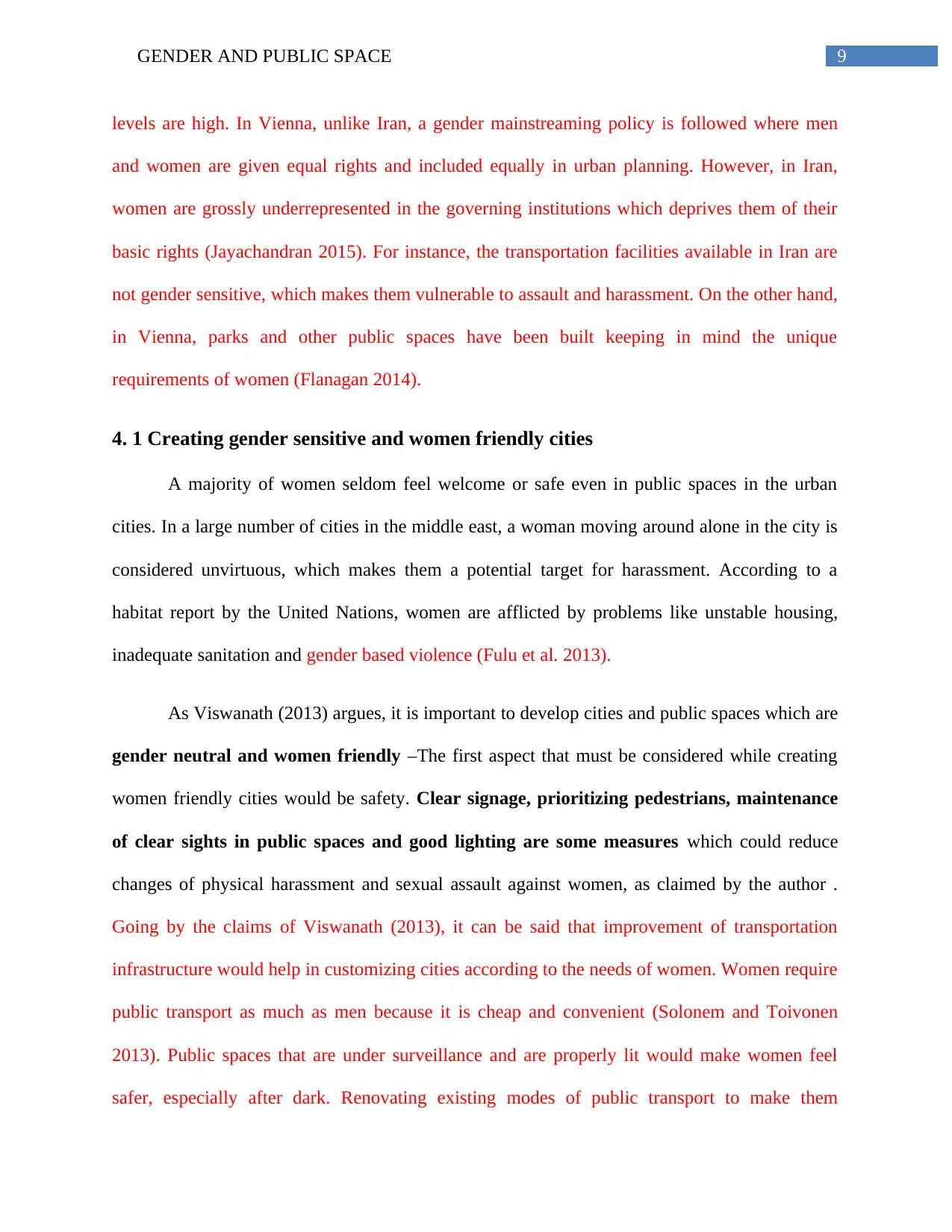
9GENDER AND PUBLIC SPACE
levels are high. In Vienna, unlike Iran, a gender mainstreaming policy is followed where men
and women are given equal rights and included equally in urban planning. However, in Iran,
women are grossly underrepresented in the governing institutions which deprives them of their
basic rights (Jayachandran 2015). For instance, the transportation facilities available in Iran are
not gender sensitive, which makes them vulnerable to assault and harassment. On the other hand,
in Vienna, parks and other public spaces have been built keeping in mind the unique
requirements of women (Flanagan 2014).
4. 1 Creating gender sensitive and women friendly cities
A majority of women seldom feel welcome or safe even in public spaces in the urban
cities. In a large number of cities in the middle east, a woman moving around alone in the city is
considered unvirtuous, which makes them a potential target for harassment. According to a
habitat report by the United Nations, women are afflicted by problems like unstable housing,
inadequate sanitation and gender based violence (Fulu et al. 2013).
As Viswanath (2013) argues, it is important to develop cities and public spaces which are
gender neutral and women friendly –The first aspect that must be considered while creating
women friendly cities would be safety. Clear signage, prioritizing pedestrians, maintenance
of clear sights in public spaces and good lighting are some measures which could reduce
changes of physical harassment and sexual assault against women, as claimed by the author .
Going by the claims of Viswanath (2013), it can be said that improvement of transportation
infrastructure would help in customizing cities according to the needs of women. Women require
public transport as much as men because it is cheap and convenient (Solonem and Toivonen
2013). Public spaces that are under surveillance and are properly lit would make women feel
safer, especially after dark. Renovating existing modes of public transport to make them
levels are high. In Vienna, unlike Iran, a gender mainstreaming policy is followed where men
and women are given equal rights and included equally in urban planning. However, in Iran,
women are grossly underrepresented in the governing institutions which deprives them of their
basic rights (Jayachandran 2015). For instance, the transportation facilities available in Iran are
not gender sensitive, which makes them vulnerable to assault and harassment. On the other hand,
in Vienna, parks and other public spaces have been built keeping in mind the unique
requirements of women (Flanagan 2014).
4. 1 Creating gender sensitive and women friendly cities
A majority of women seldom feel welcome or safe even in public spaces in the urban
cities. In a large number of cities in the middle east, a woman moving around alone in the city is
considered unvirtuous, which makes them a potential target for harassment. According to a
habitat report by the United Nations, women are afflicted by problems like unstable housing,
inadequate sanitation and gender based violence (Fulu et al. 2013).
As Viswanath (2013) argues, it is important to develop cities and public spaces which are
gender neutral and women friendly –The first aspect that must be considered while creating
women friendly cities would be safety. Clear signage, prioritizing pedestrians, maintenance
of clear sights in public spaces and good lighting are some measures which could reduce
changes of physical harassment and sexual assault against women, as claimed by the author .
Going by the claims of Viswanath (2013), it can be said that improvement of transportation
infrastructure would help in customizing cities according to the needs of women. Women require
public transport as much as men because it is cheap and convenient (Solonem and Toivonen
2013). Public spaces that are under surveillance and are properly lit would make women feel
safer, especially after dark. Renovating existing modes of public transport to make them
Paraphrase This Document
Need a fresh take? Get an instant paraphrase of this document with our AI Paraphraser
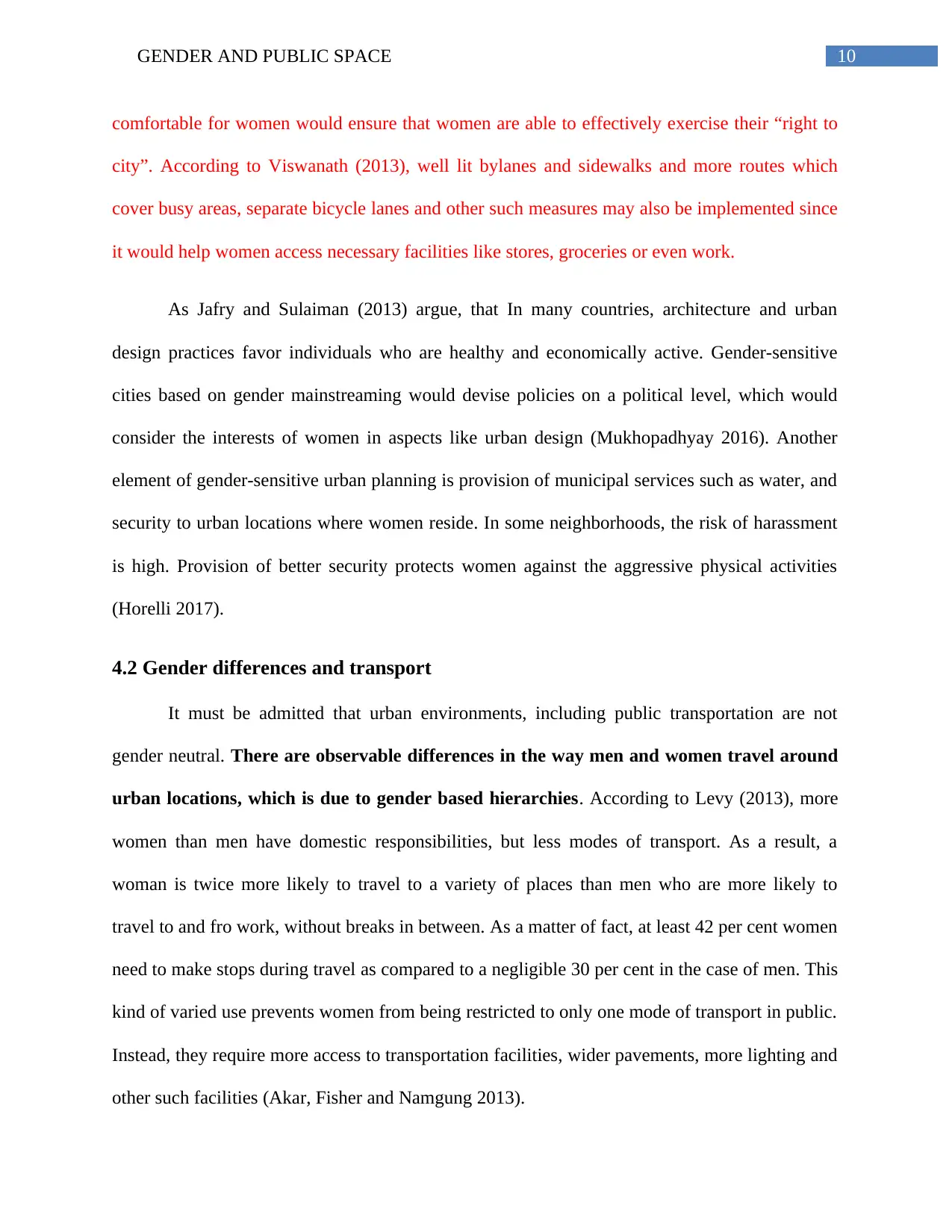
10GENDER AND PUBLIC SPACE
comfortable for women would ensure that women are able to effectively exercise their “right to
city”. According to Viswanath (2013), well lit bylanes and sidewalks and more routes which
cover busy areas, separate bicycle lanes and other such measures may also be implemented since
it would help women access necessary facilities like stores, groceries or even work.
As Jafry and Sulaiman (2013) argue, that In many countries, architecture and urban
design practices favor individuals who are healthy and economically active. Gender-sensitive
cities based on gender mainstreaming would devise policies on a political level, which would
consider the interests of women in aspects like urban design (Mukhopadhyay 2016). Another
element of gender-sensitive urban planning is provision of municipal services such as water, and
security to urban locations where women reside. In some neighborhoods, the risk of harassment
is high. Provision of better security protects women against the aggressive physical activities
(Horelli 2017).
4.2 Gender differences and transport
It must be admitted that urban environments, including public transportation are not
gender neutral. There are observable differences in the way men and women travel around
urban locations, which is due to gender based hierarchies. According to Levy (2013), more
women than men have domestic responsibilities, but less modes of transport. As a result, a
woman is twice more likely to travel to a variety of places than men who are more likely to
travel to and fro work, without breaks in between. As a matter of fact, at least 42 per cent women
need to make stops during travel as compared to a negligible 30 per cent in the case of men. This
kind of varied use prevents women from being restricted to only one mode of transport in public.
Instead, they require more access to transportation facilities, wider pavements, more lighting and
other such facilities (Akar, Fisher and Namgung 2013).
comfortable for women would ensure that women are able to effectively exercise their “right to
city”. According to Viswanath (2013), well lit bylanes and sidewalks and more routes which
cover busy areas, separate bicycle lanes and other such measures may also be implemented since
it would help women access necessary facilities like stores, groceries or even work.
As Jafry and Sulaiman (2013) argue, that In many countries, architecture and urban
design practices favor individuals who are healthy and economically active. Gender-sensitive
cities based on gender mainstreaming would devise policies on a political level, which would
consider the interests of women in aspects like urban design (Mukhopadhyay 2016). Another
element of gender-sensitive urban planning is provision of municipal services such as water, and
security to urban locations where women reside. In some neighborhoods, the risk of harassment
is high. Provision of better security protects women against the aggressive physical activities
(Horelli 2017).
4.2 Gender differences and transport
It must be admitted that urban environments, including public transportation are not
gender neutral. There are observable differences in the way men and women travel around
urban locations, which is due to gender based hierarchies. According to Levy (2013), more
women than men have domestic responsibilities, but less modes of transport. As a result, a
woman is twice more likely to travel to a variety of places than men who are more likely to
travel to and fro work, without breaks in between. As a matter of fact, at least 42 per cent women
need to make stops during travel as compared to a negligible 30 per cent in the case of men. This
kind of varied use prevents women from being restricted to only one mode of transport in public.
Instead, they require more access to transportation facilities, wider pavements, more lighting and
other such facilities (Akar, Fisher and Namgung 2013).

11GENDER AND PUBLIC SPACE
Another major difference in the way men and women perceive public transport is the
safety factor. Since most public transportation systems across the world fail to provide gender
sensitive measures, the rate of sexual harassment and atrocities against women increase. For
example, women feel extremely unsafe in public spaces like subways, bridges and access paths
(Loukaitou-Sideris 2014). The fear of being stalked, violated, attacked or assaulted has changed
the way most women use public transport. For example, women tend to travel in pairs or groups,
stick to well lit areas and avoid isolated public spaces.
To counter these issues, several measures are being taken by countries around the world
to ensure that public transport is gender neutral and gender sensitive. For example, women only
transportation systems have been implemented in a number of countries like India and some
parts of Asia and in Mexico. A case study of this is in the city of Mexico, where women only
transportation has been implemented – this is known as pink transportation. The case study
claims that the perceived threats to women’s safety are major factors that modifies and affects
travel behavior of women in public (Drunkel Gargia 2013). Women only transportation draws on
the defensible space theory by Oscar Newman. According to Jacobs and Lees (2013), spatial
design, a common concept in public space is directly related to the level of crime. It was
assumed that transportation systems which were entirely operated by women and catered to only
women customers would reduce their fear of travelling in public transport. In short, pink
transportation can be called a design out of fear in urban planning. However, Levanon and
Grusky (2016) argue that gender based segregation has reached an extreme in this century and
use of women only facilities would simply deepen the issue of gender discrimination. Such
women only transportation may further highlight the differences between men and women.
Another major difference in the way men and women perceive public transport is the
safety factor. Since most public transportation systems across the world fail to provide gender
sensitive measures, the rate of sexual harassment and atrocities against women increase. For
example, women feel extremely unsafe in public spaces like subways, bridges and access paths
(Loukaitou-Sideris 2014). The fear of being stalked, violated, attacked or assaulted has changed
the way most women use public transport. For example, women tend to travel in pairs or groups,
stick to well lit areas and avoid isolated public spaces.
To counter these issues, several measures are being taken by countries around the world
to ensure that public transport is gender neutral and gender sensitive. For example, women only
transportation systems have been implemented in a number of countries like India and some
parts of Asia and in Mexico. A case study of this is in the city of Mexico, where women only
transportation has been implemented – this is known as pink transportation. The case study
claims that the perceived threats to women’s safety are major factors that modifies and affects
travel behavior of women in public (Drunkel Gargia 2013). Women only transportation draws on
the defensible space theory by Oscar Newman. According to Jacobs and Lees (2013), spatial
design, a common concept in public space is directly related to the level of crime. It was
assumed that transportation systems which were entirely operated by women and catered to only
women customers would reduce their fear of travelling in public transport. In short, pink
transportation can be called a design out of fear in urban planning. However, Levanon and
Grusky (2016) argue that gender based segregation has reached an extreme in this century and
use of women only facilities would simply deepen the issue of gender discrimination. Such
women only transportation may further highlight the differences between men and women.
⊘ This is a preview!⊘
Do you want full access?
Subscribe today to unlock all pages.

Trusted by 1+ million students worldwide
1 out of 26
Your All-in-One AI-Powered Toolkit for Academic Success.
+13062052269
info@desklib.com
Available 24*7 on WhatsApp / Email
![[object Object]](/_next/static/media/star-bottom.7253800d.svg)
Unlock your academic potential
Copyright © 2020–2025 A2Z Services. All Rights Reserved. Developed and managed by ZUCOL.